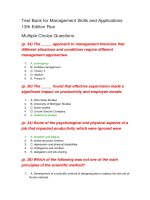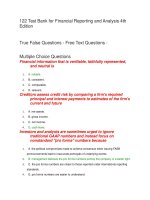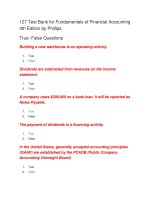Test bank for radiographic imaging and exposure 4th edition by fauber
Bạn đang xem bản rút gọn của tài liệu. Xem và tải ngay bản đầy đủ của tài liệu tại đây (36.45 KB, 4 trang )
buy this full document at
Fauber: Radiographic Imaging & Exposure, 3rd Edition
Chapter 1: Radiation and Its Discovery
Test Bank
MULTIPLE CHOICE
1. When were x-rays discovered?
a. October 8, 1985
b. November 8, 1895
c. January 23, 1896
d. August 15, 1902
ANS: B
X-rays were discovered by Wilhelm Conrad Roentgen on November 8, 1895.
2. What type of tube was Roentgen working with in his lab when x-rays were discovered?
a. Crookes tube
b. Fluorescent tube
c. High-vacuum tube
d. Wurzburg tube
ANS: A
Roentgen was working with a low-vacuum tube known as a Crookes tube.
3. Which of the following terms could be defined as the instantaneous production of light
caused by an interaction between a type of energy and some element or compound?
a. Phosphorescence
b. Afterglow
c. Glowing
d. Fluorescence
ANS: D
Fluorescence is the instantaneous emission of light from a material due to the interaction
with some type of energy.
4. Barium platinocyanide was the:
a. type of dark paper Roentgen used to darken his laboratory.
b. material Roentgen used to produce the first radiograph of his wife’s hand.
c. metal used to produce the low-vacuum tube.
d. fluorescent material that glowed when the tube was energized.
ANS: D
A piece of paper coated with barium platinocyanide glowed each time Roentgen energized
his tube.
5. The first radiograph produced by Roentgen, of his wife’s hand, required an exposure time of:
buy this full document at
Full file at />a.
b.
c.
d.
15 seconds.
150 seconds.
15 minutes.
150 minutes.
ANS: C
It took a 15-minute exposure time to produce the first radiograph.
6. The letter “x” in x-ray is the symbol for:
a. electricity.
b. the unknown.
c. penetrating.
d. discovery.
ANS: B
The letter “x” represents the mathematical symbol of the unknown.
7. The first Nobel Prize for physics was received in 1901 by:
a. Marie Curie.
b. Crookes.
c. Wilhelm Roentgen.
d. Einstein.
ANS: C
Wilhelm Roentgen received the first Nobel Prize for physics in 1901.
8. Erythema, an early sign of biological damage due to x-ray exposure, is:
a. reddening of the skin.
b. a malignant tumor.
c. a chromosomal change.
d. one of the most serious effects of x-ray exposure.
ANS: A
Erythema is reddening and burning of the skin, an early and less serious effect of exposure to
large doses of x-radiation.
9. X-rays have which of the following properties?
a. Electrical properties
b. Magnetic properties
c. Chemical properties
d. a and b
ANS: D
X-rays, a type of electromagnetic radiation, have both electrical and magnetic properties.
Mosby items and derived items © 2009, 2004, 2000 by Mosby, Inc., an affiliate of Elsevier Inc.
Full file at />10. The distance between two successive crests of a sine wave is known as:
a. an angstrom.
b. frequency.
c. the Greek letter nu.
d. wavelength.
ANS: D
The distance between two successive crests or troughs of a sine wave is the measure of its
wavelength.
11. X-rays used in radiography have wavelengths that are measured in:
a. angstroms.
b. millimeters.
c. centimeters.
d. inches.
ANS: A
X-rays in the range used in radiography have wavelengths that are so short that they are
measured in angstroms.
12. The frequency of a wave is the number of waves passing a given point per given unit of time.
Frequency is measured in:
a. angstroms.
b. Hertz.
c. inches.
d. eV.
ANS: B
The unit of frequency is Hertz. The frequency of x-rays in the radiography range varies from
about 3 × 1019 to 3 × 1018 Hz.
13. Which of the following is a correct description of the relationship between the wavelength
and the frequency of the x-ray photon?
a. Wavelength and frequency are directly proportional.
b. Wavelength and frequency are inversely related by the square root of lambda.
c. Frequency and wavelength are inversely related.
d. Wavelength and frequency have no relationship to each other.
ANS: C
Wavelength and frequency are inversely related; as one increases, the other decreases.
14. A _____ is a small, discrete bundle of energy.
a. phaser
b. quark
c. photon
d. mesion
Mosby items and derived items © 2009, 2004, 2000 by Mosby, Inc., an affiliate of Elsevier Inc.
Full file at />ANS: C
A photon, or quantum, is a small, discrete bundle of energy.
15. The speed of light is:
a. 3 × 108 meters per second.
b. 3 × 108 miles per second.
c. 186,000 miles per second.
d. a and c.
ANS: D
The speed of light can be described as either 3 × 108 m/sec or 186,000 miles/sec.
16. X-rays are invisible.
a. True
b. False
ANS: A
A characteristic of x-rays is that they are invisible.
17. X-rays carry a negative charge that causes ionization.
a. True
b. False
ANS: B
X-rays are electrically neutral.
18. X-ray photons travel at the speed of light in a vacuum.
a. True
b. False
ANS: A
In a vacuum x-rays will travel at the speed of light.
19. X-ray photons are capable of traveling around corners.
a. True
b. False
ANS: B
X-rays travel in straight lines, so they are unable to travel around corners.
20. Chemical changes may occur as a result of exposure to ionizing radiation.
a. True
b. False
ANS: A
Chemical changes, such as in radiographic or photographic film, occur as a result of
exposure to ionizing radiation.
Mosby items and derived items © 2009, 2004, 2000 by Mosby, Inc., an affiliate of Elsevier Inc.









